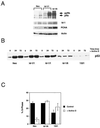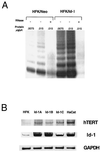Immortalization of primary human keratinocytes by the helix-loop-helix protein, Id-1
- PMID: 10449746
- PMCID: PMC22262
- DOI: 10.1073/pnas.96.17.9637
Immortalization of primary human keratinocytes by the helix-loop-helix protein, Id-1
Abstract
Basic helix-loop-helix (bHLH) DNA-binding proteins have been demonstrated to regulate tissue-specific transcription within multiple cell lineages. The Id family of helix-loop-helix proteins does not possess a basic DNA-binding domain and functions as a negative regulator of bHLH proteins. Overexpression of Id proteins within a variety of cell types has been shown to inhibit their ability to differentiate under appropriate conditions. We demonstrate that ectopic expression of Id-1 leads to activation of telomerase activity and immortalization of primary human keratinocytes. These immortalized cells have a decreased capacity to differentiate as well as activate phosphorylation of the retinoblastoma protein. Additionally, these cells acquire an impaired p53-mediated DNA-damage response as a late event in immortalization. We conclude that bHLH proteins play a pivotal role in regulating normal keratinocyte growth and differentiation, which can be disrupted by the immortalizing functions of Id-1 through activation of telomerase activity and inactivation of the retinoblastoma protein.
Figures




References
Publication types
MeSH terms
Substances
Grants and funding
LinkOut - more resources
Full Text Sources
Other Literature Sources
Research Materials
Miscellaneous

